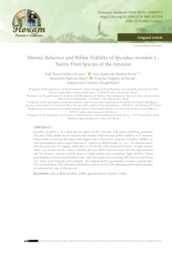Meiotic Behavior and Pollen Viability of Spondias mombin L.: native fruit species of the amazon.
Meiotic Behavior and Pollen Viability of Spondias mombin L.: native fruit species of the amazon.
Author(s): ZORTÉA, K. E. M.; ROSSI, A. A. B.; BISPO, R. B.; ROCHA, V. D. da; HOOGERHEIDE, E. S. S.
Summary: Spondias mombin L. is a fruit species native to the Amazon with great marketing potential. The aim of this study was to examine the meiotic behavior and pollen viability of S. mombin. Flower buds at various developmental stages were collected for analyses of pollen viability, in vitro germination, and meiotic behavior. S. mombin is diploid with 2n = 2x = 30 chromosomes. Meiosis showed to be regular, with only 13.3% of cells with abnormal division. A high meiotic index was found: 96.5%. Pollen viability did not differ between male (96.3%) and bisexual (96.7%) flowers, and the overall mean of viable pollen was considered high (96.5%). Pollen germination occurred in all tested media, with the treatment containing 20% sucrose and 50 mg mL‒1 boric acid being the most suitable. The highest pollen germination means occurred after 36 h of incubation. The obtained information can be used in the planning and implementation of commercial crops of the species.
Publication year: 2019
Types of publication: Journal article
Keywords: Cajá, Meiotic index, Pollen fertility, Pollen germination
Observation
Some of Embrapa's publications are published as ePub files. To read them, use or download one of the following free software options to your computer or mobile device. Android: Google Play Books; IOS: iBooks; Windows and Linux: Calibre.
Access other publications
Access the Agricultural Research Database (BDPA) to consult Embrapa's full library collection and records.
Visit Embrapa Bookstore to purchase books and other publications sold by Embrapa.

